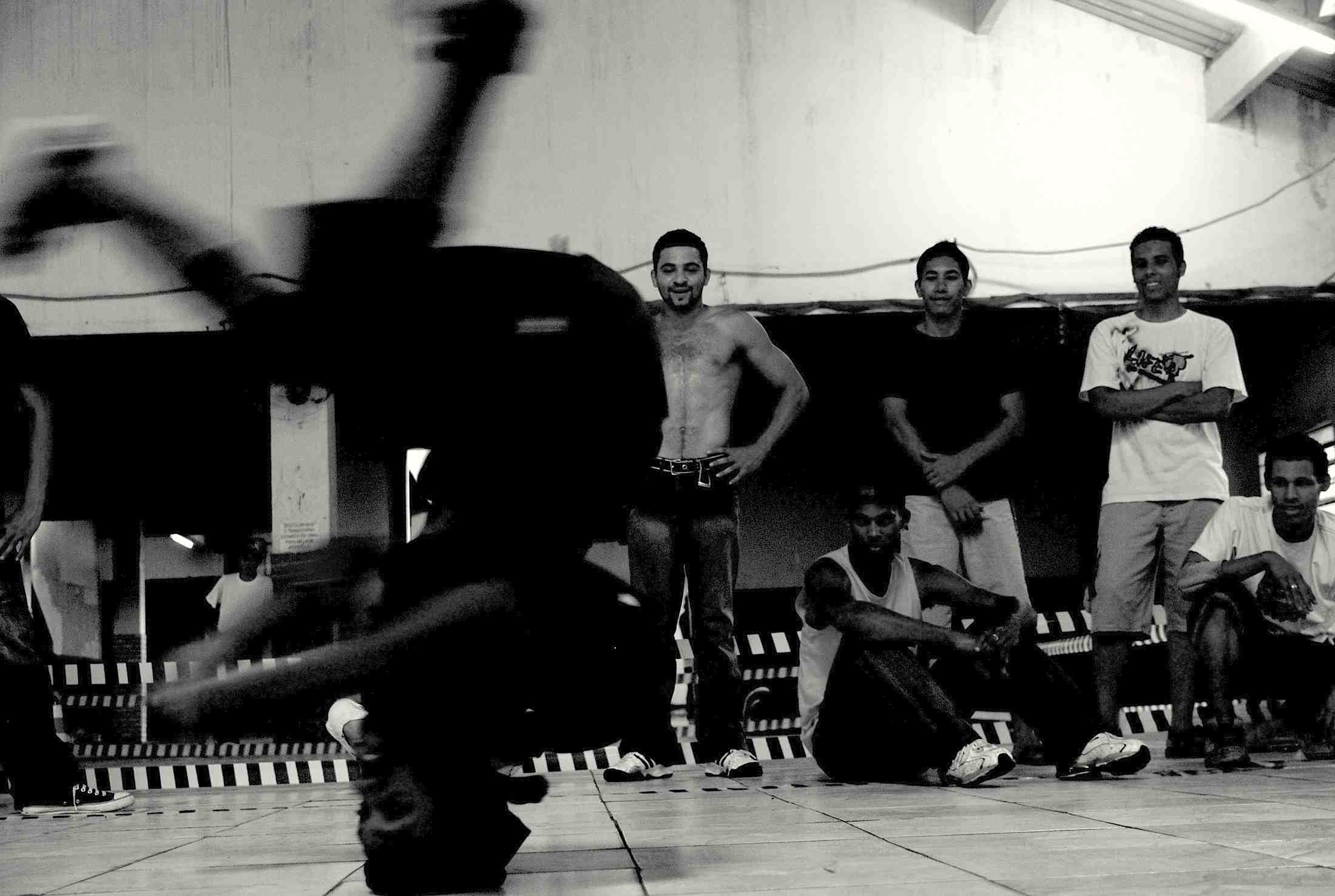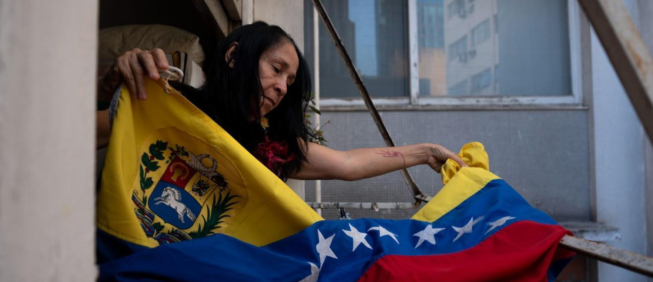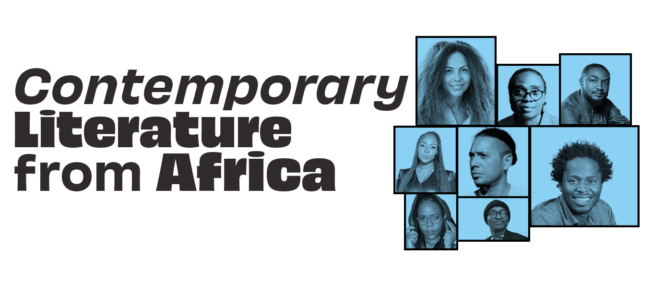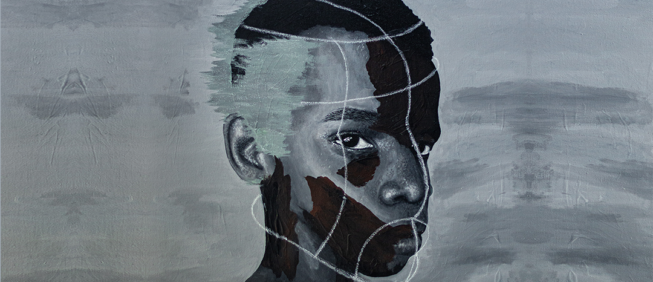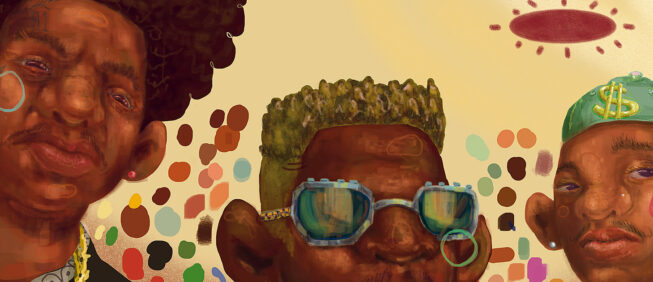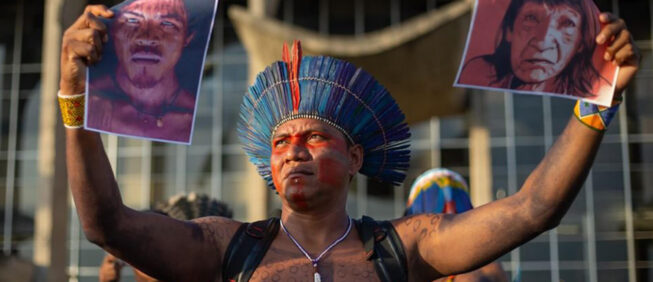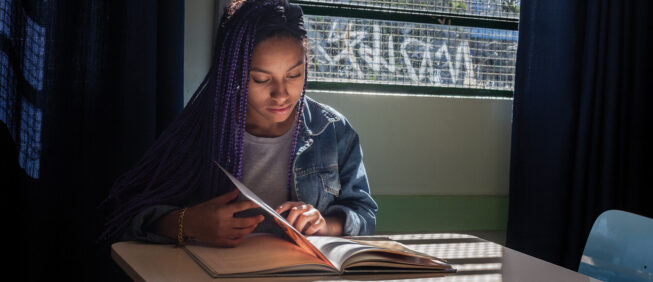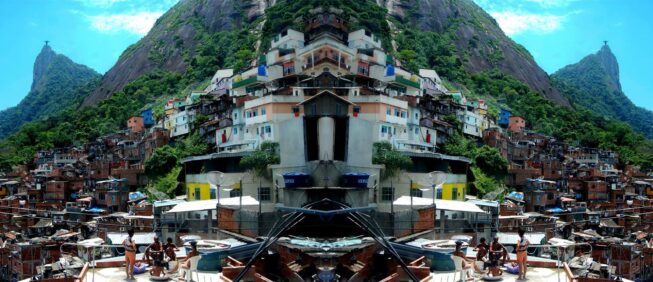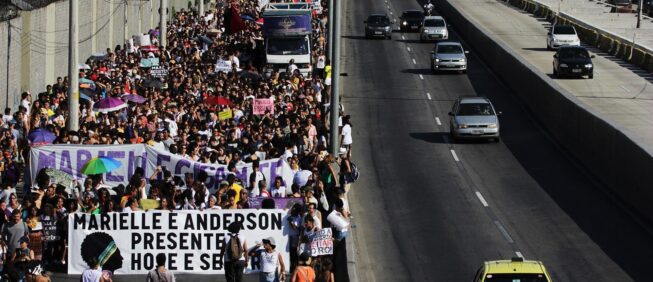Transforming the Imaginary of Marginality: Some Experiences from Rio de Janeiro
Udi Mandel Butler
| BRASIL |
May, 2018
This article is based on action-research carried out in Rio de Janeiro between 2005 and 2009 that sought to understand how young people perceived and practiced what we termed public action in the context of a socially and economically divided city. In 2005, I worked with Marcelo Princeswal and a small team of researchers from a Brazilian action/research NGO, the International Center for Research and Policy on Childhood (CIESPI), based at Rio de Janeiro’s Pontífica Universidade Católica (PUC). Our collaborative action-research explored significant spaces and practices of public action and the kinds of groups, organizations, networks, or movements that young people (mostly aged sixteen to twenty-nine) participate in (e.g. faith-based groups, development projects, community organizations, social movements, etc.). We used the term public action to emphasize the dynamic and often agonistic nature of public struggles for recognition, respect, resources, or justice.1The term public action as used in this article stems from discussions in the Non-Governmental and Public Action Research Programme, in particular through the work of Jude Howell, the program’s director. For more information on this program, including the range of projects within it, see its website at http://www2.lse.ac.uk/internationalDevelopment/research/NGPA/.
We did not, at the outset, intend to focus on the domain of the image or visual production. However, through this research we encountered a set of struggles and organizations that were deeply implicated in this domain, which I will call the imaginary. This imaginary consisted of several prejudiced representations, visual and otherwise, of inhabitants of favelas, sometimes connected to racial stereotypes. These circulated in the dominant media and were seen, by many of our interviewees, as widespread among the population of Rio de Janeiro.
Cities like Rio de Janeiro, marked as they are by deep social divisions, pose particular challenges for collective action in the public sphere and for the practice of and struggle for citizenship. Rio’s residents have at times referred to this social relationship between differing socioeconomic groups as Cidade Partida, the divided city (Ventura 2002). This term points to the relation between the favela x asfalto, the favela and the asphalt, or the semi-legal domains and the regular spaces of the city, coming to represent - in the imaginary of scholars, politicians, the media, and other inhabitants - the lack of integration in the urban environment. The term divided city, according to Fernando Fernandes, refers to a division that separates the “formal” city, with its juridically legitimized streets and properties and range of public services, from the “informal” city, a place “without urban planning, of informal occupation of land and clearly lacking in a range of services and urban provisions” (Fernandes 2004).
This article then, will address how this divided city is manifested in the domain of visual production. Here I will address how the image has become a site for struggle in places like Rio de Janeiro and at the same time how sectors of the public have mobilized to try to reconfigure or reimagine the city, counteracting the fragmenting logic of this “imaginary of marginality.” The article will also discuss certain social and cultural conditions that have provided spaces for reconnection - or as I term it here, re-imagination of the city/citizen - in an attempt to reconfigure the city’s visual economy. Given that Rio de Janeiro’s visual economy proved an important site of struggle for young people, it follows that making the visual itself can be an important site of collaboration and intervention of collaborative action-research. Following from this, the article provides an overview of a collaborative action-research project I coordinated with a group of young activist photographers in Rio de Janeiro.
Imaginary Struggles
Favelas are the squatter settlements that have occupied disused land in the city at least since the early twentieth century. The distinct geography of Rio, a city growing around the steep and forested hills close to the coast, has meant that older and more established favelas have grown upward into spaces where it was hard to build. Now in its third generation, favela residents make up 18.7 percent of the city’s population of almost six million, up from 7 percent half a century ago.
The exchange below took place amongst a group of five young people, residents from different favelas, who were part of a pilot radio project in the city dedicated to training participants to become producers of news and current affairs programs for their peers. This exchange is emblematic of a common response given by many young people involved in numerous initiatives we came to know in our research on youth participation in different forms of public action in Rio de Janeiro (in particular NGOs, cultural groups, and community organizations).
- Before I was reluctant to say I live in the Complexo da Maré [a large urban favela]. The person jolts, the person retreats, it is horrible, you have to own up, I always own up, you know, about the place where you live and it doesn’t matter, the place doesn’t make you up, it is you who makes up the place.
- My critical gaze shifted.
- Yes, our vision of society amplified, and we cannot deny our roots, I think that is it. Many people who live in the community are ashamed of saying that they live in a community, that they live in a favela.
- They feel shame.
- Afterward I started having this other perspective; I gave more emphasis to the fact of the place where I live, to my origins, to the fact of being black too.
This conversation highlights a set of key issues addressed in this article. First of all, the feeling of “shame,” of being stigmatized by particular social representations associated with the place where several young people we talked to lived, that is, in Rio’s favelas. Indeed, reluctance to admit to living in a favela in Rio is common, part of an internalized prejudice or shame addressed above. At the same time, the conversation points to how such feelings of shame are overcome through a “critical gaze,” a reappraisal of the social, political, and historical context young people find themselves in. I describe this critical graze process as a micro-revolution of identification where the individual feels a renewed connection with her/his own community, race, or ethnicity - or in other cases we found in our research, sexual orientation and even class. The effects of these transformations are variously described as concerning a sense of self-respect and pride in being part of a constituency with a particular history and culture, as well as renewed feelings of recognition of oneself and oneself by others that also connect with sentiments of dignity.
I say “micro-revolution” following philosopher, psychotherapist, and political activist Felix Guattari, who spoke of the many levels through which political (and therefore potentially revolutionary) change can occur (Guattari 1996; Guattari and Rolnik 2005). Guattari provokes us to think differently about such changes, guiding our gaze not only to the “great revolutions” due to more traditional forms of political organization and mobilization, but also to other places where the political is found, such as the local level (communities, neighborhoods, schools), the interpersonal level (how we relate with each other, our family, strangers, those who are different), and the level of subjectivity (how we feel and react, what we dream or identify with) where we are constituted and constitute ourselves as subjects. Referring to micropolitics, that is, to the crossing over between these domains, for Guattari, the crucial question becomes how we reproduce or defy dominant forms of subjectification. Subjectification, in this sense, has to do with how we come to be defined and to understand and act upon ourselves through particular discourses (Foucault 1982; Hacking 2003). Most important for the present discussion is a discussion of how both subjectification and re-imagination operate within a visual domain.
Terms like visual culture describe the embeddedness of visual representations within broader systems of meaning and in mediating social relationships. Visual discourse has been used to describe particular genres and stereotypical forms of representation that come to reflect dominant ideologies or ways of understanding people and aspects of the world. For authors like Poole, the term visual culture fails to address the power inequality often present in the production, circulation, and consumption of images; instead, the concept of visual economies is suggested to describe these processes (Poole in Pinney 2003: 8). As the term implies, these processes are deeply intermeshed with political and economic inequalities and with the resources available to produce images. The visual domain I am describing encompasses these understandings of visual culture, discourse, and economy, but it also differs in that it tries to emphasize how images are experienced by subjects and affect their emotions, identities, and imaginations. The notion of the imaginary acknowledges that images have an important role in shaping subjectivities, while also celebrating people’s capacity to reimagine, a quality inherent to the human condition.
The visual economy surrounding the favelas, consisting of the production, circulation, and consumption of images of and from these spaces to the rest of the city and the country, has been around since their emergence more than a hundred years ago. Nowadays, the most visible aspect of the way spaces are represented in this domain of the visual, at least in the dominant media, is violence. These representations emerged alongside the rise of drug trafficking gangs that have grown in strength and operate from a number of favela communities over the last two decades (Zaluar 1994). High fatality rates have resulted from drug factions’ fights between themselves for control of territory and also from police operations being carried out in these spaces. The consequences of the political economy of the drug trade in Rio, in terms of the deaths, suffering, and culture of fear, corruption, and intimidation it generates, are devastating, especially for favela inhabitants. The state’s recent attempts, using the police and the military, to occupy these communities and cast out the drug gangs have had mixed results. It remains to be seen whether more sensitive and progressive forms of policing will replace these gangs, and where the suppressed forces of the drug trade will manifest next. An undeniable effect of the drug trade and these actions taken against it has been the proliferation of images of favelas as spaces of violence, marginality, and lack, contributing to what I call the imaginary of marginality.
The imaginary of marginality is a narrative about populations historically deprived of rights, held by dominant social groups (and sometimes internalized by the marginalized themselves) often containing prejudiced representations, images, stories, sometimes connected to stereotypes around race, poverty and gender. These negative representations tend to circulate in the dominant mass media and in certain forms of research and educational systems. Unconfronted, these representations come to be widespread amongst the population and perceived as the main narrative, the norm. We often come to see and know places and people we do not personally encounter through stories and images that others create about them. These stories most commonly come to us through diverse media – newspapers, television, books, the internet, and so on. At the scale of a city, the media helps to virtually weave an imaginary web linking separated places and lives. We are most often not very mindful of this web – this matrix of images and stories, feelings and attitudes, but also a landscape we walk through in our day-to-day lives that provides a sense of meaning to us and the world around us. The texture of this imaginary web is shaped by those who weave it. Those weavers, often the most privileged sectors that dominate and own the media, have little experience or willingness to convey the stories and perspectives of the less powerful in those communities, especially through their own voice, their own point of view and experienced reality.
Since the middle of the nineteen nineties, several media and cinema theorists have taken up Benedict Anderson’s work in an attempt to understand the role of media in imagining communities. Imagined Communities (Anderson 1983) showed how nationalism emerges as a historical phenomenon whereby large groups of people come to envisage themselves as part of a community with shared attributes and a common identity. These communities - Anderson referred in particular to Creole communities in the Americas - acquired social consciousness as part of a larger group in parallel with processes of self-organization around the institutions of a state. For Anderson, a key catalyst in this phenomenon is the presence of what he called “print-capitalism,” that is, a wide availability of printed books published in the vernacular by a newly established print industry producing literature, pamphlets, newspapers and so on.2Other forms of widely circulated representations Anderson mentions include atlases and maps, which also contribute to a sense of national community (Anderson 1983). For Anderson, then - as Walsh points out in an article on cinema and nationalism - imagining refers not to a psychological faculty but to a development in “social epistemology” in which historical actors generate unintended consequences such as a collective sense of identity (see Walsh 1996).
Similarly, film and media theorists have endeavoured to trace the role of different media in the shaping of such social epistemologies. These theorists significant contributions have traced a series of “national imaginaries” in national film and television productions, analyzing tropes, tendencies, and historical shifts, as well as depictions of minority groups like immigrant communities or black and indigenous people (Araújo 2000; Ginsburg 2003; Shohat and Stam 2002; Walsh 1996).
In the context of Brazil, the chief agent of this imagining since the nineteen sixties has been the media empire of Rede Globo, one of the five largest television networks in the world. Not just a key player in terrestrial, cable, and satellite television, Globo also incorporates newspaper, magazine, and book publication, radio stations, and charitable institutions. It is by far the most watched terrestrial TV channel in Brazil, with more than 50 percent audience share, and its world-famous soap operas are a staple of the nation’s viewing diet. Rede Globo, then, is the most powerful force in Brazil’s visual economy. The story of its rise to national dominance is interesting in itself, involving a close relationship to Brazil’s military regime (1964–1985) and then continued alliance with the political and economic elite in the era of Brazilian democratization. Globo even declined to cover the huge anti-dictatorship protests that took place right up to the moment of political transition (see Mader 1993).
The extremely popular daily dose of entertainment and advertising that Globo feeds the nation, however, reflects the lifestyles and consumption habits of the country’s white upper-middle-class urban residents, often from wealthier districts of Rio de Janeiro. The Globo network, and to an extent other Brazilian broadcasters too, are very much aware of television’s power to shape public opinion and create a sense of national identity.3The extent of this media influence may even be reflected in the country’s declining birth rates, which some demographers have partly attributed to the telenovelas like those aired on Globo, which have spread through the country faster than education and show modern upper-middle-class urban families with few children and desirable lifestyles. The corporation’s slogan, constantly spoken on air - “Rede Globo, a gente se ve por aqui” (Globo Network - we see each other through here) - is a succinct encapsulation of what Anderson spoke of in Imagined Communities. Globo’s almost five decades dominating the airwaves have profoundly impacted Brazil’s imaginary, reinforcing social attitudes and forming opinions. But what happens to those who do not recognize themselves on Globo’s screen? The passage below is from a text written by Gabriela Torres as part of a collaborative book our research team developed with seven activists who had spent years engaged in public-sphere initiatives (CIESPI 2007; see also Butler 2009; Butler and Princeswal 2010).
"I like living in the favela but I would like people who live there to have the opportunity to choose, to be able to walk around freely without people getting frightened in hearing the magic word “favela”. It is there on the top of the hill-shanty that you live a harsh reality. The hard and sweet reality that you do not read about in the newspapers. Drug trafficking exists and the violence that appears on the news is not a lie. However we know that the news is manipulated to increase ratings. All this violence is perpetuated by the same people who denounce it on TV, because most people who use drugs are from the social classes A and B.4The phrase “classes A and B” refers to a sectoral classification of the population most often used in business circles and marketing and often concerns profession and training rather than purchasing power, though in this context it may well indicate upper- and middle-class individuals. The drug dealer has never left the hill-shanty and the weapons never stop arriving in ever increasing numbers. No one goes up the hill-shanty to document the fashion parades, Forró, Capoeira, Folia de reis, that is, all the cultural life of our people which is very beautiful and intense."
Like Gabriela, many people interviewed in our research, especially young people and coordinators of assorted organizations working with media and communication, expressed a feeling of misrecognition. In their perspective, media descriptions of the favelas, and consequently of their inhabitants, were often prejudiced. The favela was commonly described in terms of its lacks - of urban resources (e.g., sanitation, roads, adequate housing), the law, education and culture, productive power, or even morality. For Jailson de Souza e Silva, a Brazilian intellectual who grew up in a favela and founded an important favela-based organization, Observatório das Favelas, the problem with the perpetuation of such prejudiced perceptions - apart from the discrimination that favela inhabitants face in many aspects of their day-to-day life - is the relativizing of citizenship, whereby citizenship becomes relative to skin color, level of education, income, and/ or space inhabited in the city (Souza e Silva 2004). Observatório das Favelas works through various projects and initiatives by precisely in seeking to revert this picture – always emphasizing how the favela is part of the city and the potential it has as a territory of belonging and relationships and as a site of cultural production (see Carta da Maré, 2017).
The description below gives an example of how this imaginary of marginality is reproduced in the dominant media. Such event, which took place during my fieldwork in Rio in 2005, is in no way atypical, rather it is an ordinary example of how this imaginary is woven on a daily basis through the media. A news item on Globo’s prime-time Sunday weekly magazine program Fantástico showed Rio’s Special Operations Forces on a routine patrol of a favela. Special Operations Forces are responsible for tackling the city’s drug gangs and are considered some of the best-trained police officers. Involved in constant shoot-outs, they have developed a series of procedures for policing favelas, the latest of which is to enter these communities in armored personnel carriers. The nickname for such a vehicle is Caveirão, the Big Skull, in light of the skull and bones that is the battalion’s coat of arms. Though they protect the police from shots fired by drug gangs, favela residents greatly fear these armored vehicles. Like tanks, they drive at high speeds into some of the most densely populated places in the city. Fantástico showed what such an operation is like from inside an armored car, much in the way embedded journalists covered the Iraq War. The news piece employed a videogame aesthetic: at night, the camera looks through the window of a car patrolling the streets, looking for action. When people are seen, they quickly scatter, frightened. The expected confrontation between police and gangs fails to occur in this particular episode, but the police nevertheless oblige Globo’s voyeuristic expectations by subjecting some local residents to weapon searches.
Such police incursions are not atypical but have become part of the State’s security policy to combat the drug gangs’ favela-based operations. Here, though, I want to emphasize how the media commonly represent such operations. Fantástico’s report did not seek locals’ opinions; nor did it address the impact of such a favela “invasion,” as local residents often describe police operations. Instead it portrayed the favela as a dangerous space that must be entered with extreme caution, quickly, armed. Locals are regarded with mistrust, for all are potential criminals. These representations are part of a broader imaginary of marginality, a set of images and narrative tropes that embody a stigmatizing view of favelas,5For an important analysis and critique of how the notion of “marginality” applied to favela communities in Rio de Janeiro in the 1970s, see Janice Perlman’s The Myth of Marginality (1979 [1976]). not just as hotbeds of crime, violence, danger, and vice, but also as separate settlements that are a drain on the city, defiling panoramic views and occupying prime real estate.6 It is worth noting that alongside images of violence and crime, Brazil’s media commonly depict favelas as incessantly growing and destroying the surrounding flora. Disingenuously aligning themselves with environmental discourses, the creators of such representations fail to take into account the greater toll taken on the city’s ecology by large new condominiums, shopping centers, and private mansions.
I present the example of the Caveirão to show how different forms of alternative media are resisting this imaginary. These different spaces, or sites of re-representation of the favela, in turn illuminate the current configuration of the field of public action in which youth participate. The patrol site of the armored car in the Globo piece happened to be next to the Observatório das Favelas, mentioned above. This organization, and others like it that operate in different favelas on varying scales and with different degrees of success, see their role as involving the formation of technically competent, politically aware groups inside low-income communities. A key element in many such initiatives is “critical communication”: registering, producing, and diffusing everyday experiences and practices present in these communities.
Since the nineteen nineties, Rio de Janeiro has seen a marked increase in the number of NGOs focused on youth living in the city’s favelas. Many of the initiatives that work with young people do so through cultural forms such as music, dance, and theater. Regarded as means of engaging people in a process of cultural and community affirmation, these forms also stimulate critical reflection on the socio-political situation youth and the country find themselves in. More recently, several projects and organizations have worked to similar ends using media like cinema, news production, and photography. Such approaches are directly descended from the Popular Education movement, which motivated many campaigns and projects across the Latin American Left in the 1960s and 1970s. The Popular Education movement centered on areas like adult literacy, popular and union movements, and education movements in favelas, urban peripheries, and politically-engaged church communities, particularly those linked to Liberation Theology. The broader political movement articulated through Liberation Theology sought to integrate historically marginalized populations into society through a Christian and Marxist political framework and imaginary.
The guiding principles of Popular Education, whose foremost advocate was Brazilian teacher, philosopher, and activist Paulo Freire, promote a struggle for education as an emancipatory force, a practice of freedom, and a precondition for democratic life (Freire 1976; 1984; 1987; 1993 [1970]). As such, Popular Education is a politico-pedagogical process opposing colonial or colonizing education and attempting to reverse the negative effects that many decades of such education have had on the popular classes (Graciani 1999).
Freire’s pedagogical approach focused on the idea of dialogue and departure from the student’s cultural context. By reflecting on personal experience, social relations, culture, and history, he held, individuals can develop the ability to perceive the social, political, and economic contradictions surrounding them and consequently take action against the oppressive elements of this reality, both individually and collectively (Freire 1976; 1984; 1987; 1993 [1970]). Crucially relevant here is how numerous initiatives in the public sphere, like the community organizations described above or less formalized associations centered on cultural forms like hip- hop, have acted as spaces of reimagining self and society.7Hip-hop culture is often regarded as including four elements: rap (a musical form of singing and rhyming), break dancing, graffiti, and the DJ. Hip-hop may be too diverse to be called a movement, as it encompasses various tendencies, from the more progressive to those that eulogize crime factions, to religious hip-hop, right-wing hip-hop, homophobe hip-hop, etc. Yet despite this diversity, the Brazilian case tends strongly to- ward mobilization for social justice and citizenship and against racism, discrimination, and inequality. Our research observed hip-hop’s proximity to feminist, landless, Black, and other social movements. As privileged sites for critical reflection and the re-creation of self and community, these spaces of encounter have catalyzed the micro-revolutions discussed at the start of the chapter, producing new representations that have begun to circulate through the city’s imaginary.
A pioneering project of the Observatório das Favelas is the Escola Popular de Comunicação Crítica (Popular School of Critical Communication), which was launched in 2005 with a class of forty-two students. This project is a one-year vocational course in different media (print, Internet, video, photography, radio), designed to train young people from Rio’s favelas and peripheries to become critical communicators able to engage with and challenge the fragmented imaginary. The school’s goal is to establish local production facilities in the students’ communities of origin and equip them with the skills to enter the media market. The school also hopes to replicate its methodology from elsewhere in Brazil. As some Brazilian commentators have pointed out, it is the recognition of the dominant media’s power to spread values, representations, and attitudes which has spurred the rise of counter- hegemonic practices in the public sphere among those who struggle for social justice and citizenship (Coutinho and Paiva 2007).
The Caveirão was very topical when I first met people from the school in 2005 (and it continues to be to this day). They were discussing how their reports could reflect the community’s experiences facing such invasions. Some of their pieces circulated in the alternative media sphere, particularly via community news websites. The stories described the Caveirão’s reckless entry into the favela and the Special Operations Forces’ actions, which traumatized the local population - as did their language. Blared through the armored car’s loudspeakers as the forces entered the favela, it was reported to be at times abusive and intimidating, calling, for instance: “We have come to take your souls!” (Amnesty International 2006). This community journalism has also covered deaths at the hands of police during such incursions (Amnesty International 2006).
Significantly, considering the theme of this article, another Observatório project works specifically with “popular photographers”: young people from favelas and urban peripheries who then go on to develop their own projects, such as photographing day-to-day life in these communities.8 Photographers from this project have carried out photo assignments such as “Sport in the Favela” and “The Favela Sees the Favela,” which emphasize the depiction of everyday life in these spaces on the premise that through such re-presentation, images that more faithfully depict the experiences of favela residents will come to circulate in the national imaginary. In this, they appear to have succeeded. Their photographic exhibitions have been installed in places of power, including Brazil’s parliament in Brasilia, where members of the project met with President Lula to present him with samples of their work (Valdean 2008). More recently, Francisco Valdean’s successful blog has shown his latest photographic work as well as his analysis and commentary regarding current issues in the city and favelas (see http://www.ocotidiano.com.br). Highlighting the non-homogenous nature of institutions such as Globo itself, the photography project Imagens do Povo was recently awarded the corporation’s social project award, Makes a Difference, and its images appeared in Globo’s Sunday newspaper magazine.
A Collaborative Action-research Intervention
As addressed elsewhere (Butler 2009; Butler and Priceswal 2010), our action-research in Rio de Janeiro also involved collaborative approaches to inquiry and dissemination that sought to engage with audiences beyond academia. One such project was the co-creation of a book with seven young activists who were deeply engaged in the city’s public sphere in diverse ways. This co-created text illustrated the trajectories of their engagement and what it has meant for them (CIESPI 2007). For instance, two of the authors, sisters Diana and Diane, described their involvement in a range of community and educational projects in the area where they live, and increasingly in committees and associations working for the rights of black women citywide. Eron detailed his political trajectory from activism in school unions to work in a youth worker union and a series of regional rights forums. Quênia wrote of her political awakening and her identifying as an Afro-Brazilian through her encounter with hip-hop culture.
In a subsequent stage of the research, we encountered various issues pertaining to the imaginary struggle addressed here and in response devised an experiment involving the medium of photography instead of writing (for the challenges of such collaborative writing projects, see Butler 2009). In this participatory photographic project, I worked with five young photographers from Rio de Janeiro’s favela communities to capture the spaces and forms of public action that involved young people. Two of the young photographers are quite accomplished: Gabriela Torres has long been involved in community education initiatives, and Manuelle Rosa wrote in the above co-created publication about her trajectory from serving in local church and community organizations to working in community media. The other three photographers on the team - Vânia Bento, Francisco Valdean, and Davi Marcos - were veterans of photography projects in low-income communities and had considerable experience of photography and involvement in community organizations. Davi and Francisco both went through Observatório das Favelas’ Popular School of Critical Communication.
This photographic collaboration aimed to understand the diversity of spaces and practices of young people’s engagement in public action in Rio de Janeiro from the perspective of young people themselves, using the medium of photography. We also wanted to communicate this understanding through a mobile exhibition presented to different audiences across the city: young people from different social backgrounds; practitioners working in community organizations and NGOs; local and international researchers; and the general public, too.
The project began in September 2008, when the five photographers and I held a series of meetings to discuss the concept of “participation in public action” and the kinds of activities and spaces that might be important to photograph. The group brought examples of their work, made plans of the photographs to be taken, and began to think about where and how to hold the final exhibition in Rio. From December to May 2009, we collectively selected photographs for display and made plans for the traveling exhibition. Around 150 people attended the opening event of the first exhibition, held at a media NGO in the city center. The photographers introduced their work and spoke of their experiences of taking photographs, being engaged in social issues, and growing up in favela communities. This discussion elicited lively responses from those present, a mixture of students, young people, professionals from the nongovernmental sector, and educators across the social spectrum. Whereas the audience overall was very supportive of the photographers and their chosen trajectories of engagement with community activism, photojournalism, and art photography, one or two prejudiced voices considered such media as the preserve of higher social classes. Their argument, which I have heard before at similar events involving favela residents’ use of audio-visual technologies, was that people from these communities should instead concentrate their efforts on more manual occupations. Though some members of Brazilian society still hold such views, they have become less acceptable, especially since the recent surge of audio-visual productions from these communities. The exhibition then proceeded to the grounds of Brazil’s distinguished PUC University, which was hosting the Latin America Studies Association annual conference. An important reason the exhibition was shown here, at one of the city’s most elite universities, was that many of its students remained unaware of the living conditions, struggles, and cultural richness of people their own age living in favela communities neighboring their own homes (see Figure 1). After PUC, the exhibition material was handed back to the photographers, who themselves subsequently organized exhibitions in different venues, including Rio de Janeiro State University (where one of them studied) and schools and cultural venues in different favelas where three of the photographers live (see Figure 2). At these sites, the exhibition was accompanied by film screenings and discussions with young people and local residents.
The process of making and disseminating these images across diverse spaces in the city was exciting and challenging; most significantly, it allowed me and others to submerse ourselves in, and emerge with a clearer sense of, the imaginaries that many of my young acquaintances inhabited. The encounters the project entailed - between the photographers, their work, and others across the city - in turn created creative, inspiring opportunities for exchanges that forged new relationships. For instance, a “comment book” in which visitors jotted their reflections on the exhibition was filled with enthusiastic responses from people across the city’s social spectrum. Studying the images themselves also increased my own understanding of the diversity of the places and actions that the photographers associated with public action, which also appear significant for many young people.

Credit: Udi Mandel Butler
Credit: Francisco Valdean
These images, including the examples displayed here, also show that the occupation and transformation of public spaces and attitudes go beyond traditional understandings of the political. For instance, a photograph taken by Davi Marcos (Figure 3) recognizably represents political action in public space but also offers an image counter to that described through the perspective of Rede Globo and the Caveirão, of favela residents protesting police killings of young people in their communities.

Credit: Davi Marcos
Another Davi Marcos photograph (Figure 4) represents a form of mass occupation of public space, this one more carnivalesque: the city’s LGBT Pride Parade, which annually attracts more than a million participants and promotes awareness about rights and discrimination in the domain of sexuality. The theme of the carnivalesque is also clear in Vânia Bento’s photograph (Figure 5) of a local youth samba school in the favela where she lives. In Rio de Janeiro, samba schools’ long history as sites of popular expression of the art and experiences of the favelas constitutes an important lens through which to view these places, for the rest of the country and beyond.

Credit: Davi Marcos
Credit: Vânia Bento
Our group’s photographs also revealed surprising - and for me previously unseen -manifestations of public action, such as Davi’s shot of anarcho-punks, whose performances in the city’s public squares mix music, politics, and the occupation of public space (see Figure 6). An approach to public space that fuses art and the political is also evident in Manuelle Rosa’s photograph of a theater troupe that also uses public space to stage shows that often address political themes (see Figure 7).

Credit: Davi Marcos
Credit: Manuelle Rosa
Another important site of public action, especially for young people from favelas, involves access to university education. Multiple community organizations, often run by university students from these areas, have emerged to help young people from favelas and peripheries study to pass the university entrance exams. Francisco’s photograph (Figure 8) of one such group of students hiking to the top of one of the large hills surrounding the urban landscape captures the sense of achievement such initiatives involve for those taking part. Gabriela’s photograph of folkloric celebration in a favela evokes the central role that young people still play in rural traditions transposed into an urban environment, as well as these activities’ importance in building local communities and simultaneous invisibility to the rest of the city (see Figure 9). Whereas Gabriela’s photograph shows the continuity of the rural in the urban, Francisco’s picture of hip-hop culture (Figure 10) shows this new urban culture’s significance to both creation of new forms of artistic expression and education and political association (see note 9).

Credit: Francisco Valdean
As a form of public visual anthropology, this project allowed mutual learning and the quality of surprise to emerge within the group and beyond as images and ideas were produced and experiences shared in a way not restricted to a mere exchange of words. At the same time, dissemination of images showing young people across social groups engaged in action in the city’s public sphere facilitated wider circulation, beyond what such images, and the ideas they hold, might have had in a solely textual form.9My goal in comparing images to text is not to favor one over the other; clearly text is central to any discursive activity and our discipline would collapse without it. Yet at the same time, a rich tradition in visual anthropology argues for the importance of attentiveness to what images do in society and how we, as researchers, can deploy them.

Credit: Gabriela Torres
Credit: Francisco Valdean
The Role of Academia and Action-research in Imaginary Struggles
The theme of media and citizenship, also called “visual inclusion,” has gained importance in Brazil’s public sphere since the late nineteen nineties. Though much more recent than community radio’s penetration of favela communities, alternative media production centers and dissemination networks are now intensifying their activities, especially by appropriating new forms of technology such as digital video and the Internet. Interesting in this respect is that such movements have been taking place not only “from below,” through civil society initiatives such as those presented here, but also through government programs. During his tenure, Brazil’s Minister of Culture Gilberto Gil, also a popular musician, implemented a national project intended to motivate local cultural production in marginalized communities by disseminating their productions across Brazil via digital technologies and the Internet. To date, more than 650 “points of culture” have been established countrywide in favelas, indigenous communities, quilombos (historic runaway slave communities), and other marginalized settlements (Butler and Simões 2010; Pontos de Cultura 2011). The innovation in this initiative is its emphasis on horizontal exchanges across the different communities under the slogan of “digital inclusion” (Pontos de Cultura 2011).
Local groups’ appropriation of film, video, and photography to represent themselves in different contexts has had huge significance in the sphere of visual inclusion across the world. The rise of indigenous media production since the late 1980s - particularly among Australian Aborigine communities (Batty 1995; Ginsburg 1991; Michaels 1991), the Kayapo in the Amazon (Turner 1990; 1992a), Maoris in New Zealand, and First Nations people in Canada (Dowmunt 1995; Fox 1995), though other examples abound - points to the importance of visual modes of representation within broader struggles for autonomy and cultural expression. Production and dissemination technologies, in particular video and satellite broadcasting, were appropriated when members of these communities perceived their culture and language as threatened by the increasing prevalence of the dominant national media, especially with the introduction of national satellite coverage (Ginsburg 1991; 1995; 2003) or else by more immediate hazards to culture and territory (Turner 1990; 1992a). Ginsburg wrote of such communities’ use of audio-visual and broadcast technologies as a powerful means of “self-production” that in many cases has had culturally revitalizing effects (Ginsburg 1991; 1994; 2002). These initiatives, some of them under way for many decades, have on many occasions directly involved engaged academics, especially from the social sciences. Some of them have encouraged and promoted uptake of these tools by working with local groups, whereas others have been active writing of these ventures and analyzing them.
Our research project in Rio de Janeiro did not initially aim to study media representations of the favela or focus on media productions that involved young people in these spaces. Nevertheless, we ultimately found these to be significant themes relating to youth participation in the public sphere. The sense of stigma and the feeling of misrecognition of representations of favelas in the dominant media, along with the actual prejudice and discriminations these are held to have encouraged, were common grievances among the young people we talked to. Participating in the different initiatives we came across - NGOs, cultural groups, hip-hop collectives - clearly sharpened their critical perspectives, as described in this chapter’s opening. Although our interlocutors’ perceptions and experiences did not necessarily reflect majority opinion in the city’s favelas, they appear to be meaningful among those more engaged in the public sphere. In this particular domain of the imaginary struggles of Rio de Janeiro’s public sphere, then, an engaged researchers’ role is then to connect with such sites of resistance that are striving to re-imagine the city and the idea of citizenship in a more inclusive way.
Acknowledgments
The research this article is based on was part of the ESRC’s (Economic and Social Research Council, U.K.) Non-Governmental and Public Action Programme. The research project “Parallel Lives, Different Worlds: Citizenship and Public Action” in Rio de Janeiro took place between 2005 and 2009. This research was conducted with Marcelo Princeswal, with whom I have published elsewhere (Butler and Princeswal 2010). I am also very grateful to Sam Beck, Kelly Teamey, and Carlos Flores, who provided many insightful comments on an earlier draft, as well as to Michael Butler and Nina Simões, who encouraged me to tell more about the photographs shown here. I am also grateful for the collaboration of Francisco Valdean, Gabriela Torres, Manuelle Rosa, Davi Marcos and Vânia Bento in this project.
Udi Mandel Butler’s action-research has been mainly with children and young people living in a context of urban poverty in Rio de Janeiro, in particular those living on the street and in the favelas. His recent work also engages with innovative higher education initiatives from around the world emerging from social, ecological movements and indigenous communities, who are re-imagining what the university can be. This work, which includes writing and filmmaking can be seen at enlivenedlearning.com.
Amnesty International. 2006. “‘We Have Come to Take Your Souls’: The Caveirão and Policing in Rio de Janeiro.” Amnesty International Report (March).Anderson, Benedict. 1983. Imagined Communities. New York: Verso.
Araújo, Joel Zito. 2000. A negação do Brasil: identidade racial e estereótipos sobre o negro na história da telenovela brasileira. São Paulo: SENAC.
Batty, Philip. 1995. “Singing the Electric: Aboriginal Television in Australia.” In Channels of Resistance: Global Television and Local Empowerment, ed. Tony Dowmunt. London: British Film Institute.
Butler, Udi Mandel. 2009. “Notes on a Dialogical Anthropology.” Anthropology in Action 16, no. 3: 20–31.
Butler, Udi Mandel, and Marcelo Princeswal. 2010. “Cultures of Participation, Young People and Public Action in Brazil.” Community Development Journal 45, no. 3: 335–345.
Butler, Udi Mandel, and Nina Simões. 2010. “Culture Hot-Spots: An Anthropological ‘Do-In’?” http://www.lab.org.uk/index.php/cultures/263-culture-points.
CIESPI. 2007. Nós: A Revolução de Cada Dia. CIESPI/PUC: Rio de Janeiro. Coutinho,
Eduardo, and Raquel Paiva. 2007. “Escola Popular de Comunicação Crítica: uma experiência contra-hegemônica na periferia do Rio de Janeiro.” Journal of the Associação Nacional de Programas de Pós-Graduação em Comunicação. Available at: http://www.compos.org.br/seer/index.php/e-compos/article/viewFile/142/143.
Dowmunt, Tony, ed. 1995. Channels of Resistance: Global Television and Local Empowerment. London: British Film Institute.
Fernandes, Fernando. 2004. “Cidade partida: Partida?” http://www.observatoriodefavelas.org.br.
Foucault, Michel. 1982. “The Subject and Power.” In Michel Foucault: Beyond Structuralism and Hermeneutics, ed. Hubert Dreyfus and Paul Rabinow. New York: Harvester Wheatsheaf.
Fox, Derek Tini. 1995. “Honouring the Treaty: Indigenous Television in Aotearoa.” In Channels of Resistance: Global Television and Local Empowerment, ed. Tony Dowmunt. London: British Film Institute.
Freire, Paulo. 1976. Ação Cultural Para Liberdade. Rio de Janeiro: Editora Paz e Terra.
---. 1984. O Papel do Educador. São Paulo: Documentos FEBEM.
---. 1987. Paulo Freire e educadores de rua: Uma abordagem crítica. Projeto Alternativas de Atendimento aos meninos de rua. Rio de Janeiro: UNICEF/SAS/FUNABEM.
---. 1993 [1970]. Pedagogy of the Oppressed. London: Penguin Press.
Ginsburg, Faye. 1991. “Indigenous Media: Faustian Contract or Global Village?” Cultural Anthropology 6, no. 1: 92–112.
---. 1994. “Culture/Media: A (Mild) Polemic.” Anthropology Today 10, no. 2: 5–15.
---. 1995. “Production Values: Indigenous Media and the Rhetorics of Self-determination.” In Rhetorics of Self-Making, ed. Debbora Bataglia. Berkeley: University of California Press.
---. 2002. “Mediating Culture: Indigenous Media, Ethnographic Film, and Production of Identity.” In The Anthropology of Media: A Reader, ed. Kelly Askew and Richard Wilk. Oxford: Blackwell.
---. 2003. “Shooting Back: From Ethnographic Film to Indigenous Production/Ethnography of Media.” In A Companion to Film Theory, ed. Toby Miller and Robert Stam. Oxford: Blackwell.
Graciani, Maria Stela. 1999. Pedagogia Social de Rua. São Paulo: Cortez Editora. Granada Television. 1969–1993. Disappearing World.
Guattari, Felix. 1996. Soft Subversions. New York: Semiotext.
Guattari, Felix, and Suely Rolnik. 2005. Micropolítica: Cartografias do desejo. Petrópolis, Brazil: Vozes.
Hacking, Ian. 2003. “Between Michel Foucault and Erving Goff man: Making Up People.” Lecture held at London School of Economics. Unpublished.
Mader, Roberto. 1993. “Globo Village: Television in Brazil.” In Channels of Resistance: Global Television and Local Empowerment, ed. Tony Dowmunt. London: British Film Institute.
Michaels, Eric. 1991. “Aboriginal Content: Who’s Got It -Who Needs It?” Visual Anthropology 4, no. 3–4: 277–300.
Observatório das Favelas. 2017. ‘Carta da Maré’. http://observatoriodasmetropoles.net/index.php?option=com_k2&view=item&id=1963%3Acarta-da-maré-as-periferias-e-seu-lugar-na-cidade&Itemid=164&lang=en
Perlman, Janice. 1979 [1976]. The Myth of Marginality: Urban Poverty and Politics in Rio de Janeiro. Berkeley: University of California Press.
Pink, Sarah. 2004. “Applied Visual Anthropology Social Intervention, Visual Methodologies and Anthropology Theory.” Visual Anthropology Review 20, no.1: 3–16.
Pinney, Christopher. 2003. “Introduction: ‘How the Other Half ...’” In Photography’s Other Histories, ed. Christopher Pinney and Nicolas Peterson. Durham, NC: Duke University Press.
Pinney, Christopher, and Nicolas Peterson, eds. 2003. Photography’s Other Histories. Durham, NC: Duke University Press.
Pontos de Cultura. 2011. Overview of ‘Pontos de Cultura’ in project website. http://www.cultura.gov.br/culturaviva/ponto-de-cultura/.
Shohat, Ella, and Robert Stam. 2002. “The Imperial Imaginary.” In The Anthropology of Media: A Reader, ed. Kelly Askew and Richard Wilk. Oxford: Blackwell.
Souza e Santos, Jailson de. 2004. “Meios de comunicação e espaços populares.” www.observatoriodefavelas.org.br.
Turner, Terence. 1990. “Visual Media, Cultural Politics and Anthropological Practice: Some Implications of Recent Uses of Film and Video among the Kayapo of Brazil.” CVA Review (Commission on Visual Anthropology, Montreal) (Spring): 8–13.
---. 1992a. “Defiant Images: The Kayapo Appropriation of Video.” Anthropology Today 8, no. 6: 5–16.
---. 1992b. “The Kayapo on Television: An Anthropological Viewing.” Visual Anthropology Review 8, no. 1: 107–112.
Valdean, Francisco. 2008. “Encontro com o Lula.” www.observatoriodefavelas.org.br.
Ventura, Zuenir. 2002 [1994]. Cidade Partida. São Paulo: Compania das Letras.
Walsh, Michael. 1996. “National Cinema, National Imaginary.” Film History 8, no. 1: 5–17.
Zaluar, Alba. 1994. Condomino do Diabo. Rio de Janeiro: Editora Revan.
Udi Mandel Butler | |
Faculty and Chair Of Sustainable Development at the Graduate Institute, SIT, Vermont USA. Udi is also a researcher at the International Center for Research and Policy on Childhood (CIESPI) in Rio de Janeiro and is a member of the international committee of Peripheries International. Udi has also held faculty positions in anthropology at a number of universities in the UK.
